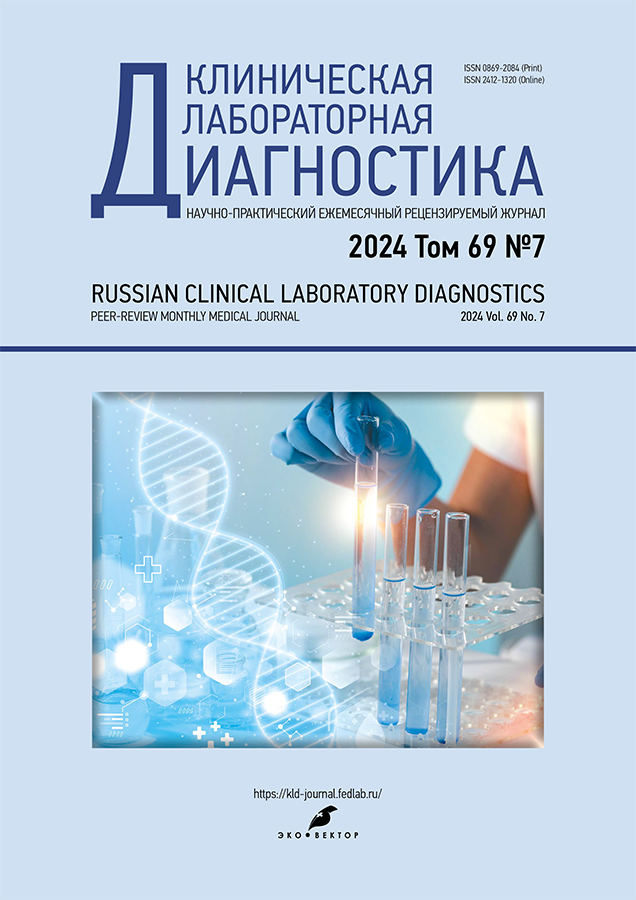Quality control of laboratory parameters of the thrombodynamics test in real clinical practice: cross-sectional study
- Авторлар: Startseva O.N.1
-
Мекемелер:
- Nikiforov Russian Center of Emergency and Radiation Medicine
- Шығарылым: Том 69, № 7 (2024)
- Беттер: 56-69
- Бөлім: Original Study Articles
- ##submission.datePublished##: 27.08.2024
- URL: https://kld-journal.fedlab.ru/0869-2084/article/view/630211
- DOI: https://doi.org/10.17816/cld630211
- ID: 630211
Дәйексөз келтіру
Аннотация
BACKGROUND: In-laboratory quality control determines the correctness and reliability of research. Coagulological research should comply with the general requirements for the standardization of clinical and laboratory studies developed by the International Organization for Standardization, World Health Organization, and Ministry of Health of Russia.
AIM: To verify the integral method of studying the hemostasis system, namely, “thrombodynamics,” and its successful use in real clinical practice.
MATERIALS AND METHODS: This study used citrate fresh plasma obtained from 14 patients according to the standard rules of blood collection and in compliance with all conditions of the pre-analytical stage for coagulological studies and commercial pooled plasma.
RESULTS: The coefficients of variation (individual and group) for the hypo, normo, and hyper models were ≤10%, indicating that the analytical characteristics obtained in the laboratory correspond to the recommended characteristics of the manufacturer. A sample preparation algorithm of three levels has been developed for commercial control of plasmas.
CONCLUSION: The thrombodynamics test enables obtaining information about the risks of bleeding and thrombosis and evaluating the effectiveness of anticoagulant therapy with heparins.
Негізгі сөздер
Толық мәтін
Авторлар туралы
Olga Startseva
Nikiforov Russian Center of Emergency and Radiation Medicine
Хат алмасуға жауапты Автор.
Email: startceva@mail.ru
ORCID iD: 0000-0003-3524-3603
SPIN-код: 3817-5670
Cand. Sci. (Biology)
Ресей, 4/2 Academic Lebedev Str., St. Petersburg, 194044Әдебиет тізімі
- Dolgov VV, Vavilova TV, Svirin PV. Laboratory diagnosis of hemostasis disorders. Moscow: Triada, 2019. (In Russ).
- Sinauridze EL, Vuimo TA, Tarandovskiy ID, et al. Thrombodynamics a new global coagulation test: Measurement of heparin efficiency. Talanta. 2018,180:282–291. doi: 10.1016/j.talanta.2017.12.055
- Gracheva MA, Balandina AN, Ataullakhanov FI, Roitman EV. Comparison of responses of integrated and screening tests for hemostasis assessment to various coagulation states in models in vitro. Tromboz, gemostaz i reologia. 2016,(4(68)):64–71. EDN: XAGIWP
- Soshitova NP, Karamzin SS, Balandina AN, et al. Predicting prothrombotic tendencies in sepsis usingspatial clot growth dynamics. Blood Coagul Fibrinolysis. 2012,23(6):498–507. doi: 10.1097/MBC.0b013e328352e90e
- Gracheva MA, Urnova ES, Sinauridze EI, et al. Thromboelastography, thrombin generation test and thrombodynamics reveal hypercoagulability inpatients with multiple myeloma. Leuk Lymphoma. 2015,56(12):3418–3425. doi: 10.3109/10428194.2015.1041385
- Koltsova EM, Balandina AN, Grischuk KI, et al. The laboratory control of anticoagulant thromboprophylaxis during the early postpartum period after cesarean delivery. J Perinat Med. 2018,46(3):251–260. doi: 10.1515/jpm-2016-0333
- Balandina AN, Koltsova EM, Shibeko AM, Kuprash AD, Ataullakhanov FI. Thrombodynamics: a new method to the diagnosis of hemostasis system disorders. Pediatric Hematology/Oncology and Immunopathology. 2018,17(4):114–126. EDN: QQQHBE doi: 10.24287/1726-1708-2018-17-4-114-126
- Dashkevich NM, Vuimo TA, Ovsepyan RA, et al. Effect of Pre-Analytical Conditions on the Thermodynamics Assay. Тhrombosis Research. 2014,133(3):472–476. doi: 10.1016/j.thromres.2013.12.014
- Wu T, Xia X, Chen W, Fu J, Zhang J. The effect of anti-Xa monitoring on the safety and efficacy of low-molecular-weight heparin anticoagulation therapy: A systematic review and meta-analysis. Journal of Clinical Pharmacy and Therapeutics. 2020,45(4):602–608. doi: 10.1111/jcpt.13169
- Startseva ON, Vavilova TV, Kornev VI, Zybina NN. Laboratory evaluation of the anticoagulant therapy effect: comparative characteristics of the thrombodynamics assay and anti-Xa activity measurement. Preventive and clinical medicine. 2023,(2(87)):97–102. EDN: WLXWGW doi: 10.47843/2074-9120_2023_2_97
- Salukhov VV, Kryukov EV, Varavin NA, Startseva ON. Comparison of thrombodynamic tests with determination of anti-Xa activity in evaluation of the efficacy of anticoagulant therapy in patients suffering deep vein thrombosis of the lower extremities. Bulletin of the Russian Military Medical Academy. 2024,26(1):79–86. doi: 10.17816/brmma568480
- Balandina AN, Serebriyskiy II, PoletaevAV, et al. Thrombodynamics — a new global hemostasis assay for heparin monitoring in patients under the anticoagulant treatment. PLoSOne. 2018,13(6). doi: 10.1371/journal.pone.0199900
Қосымша файлдар




















